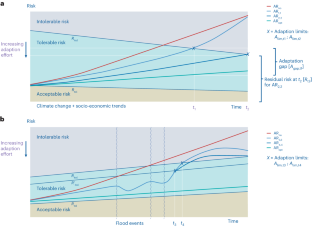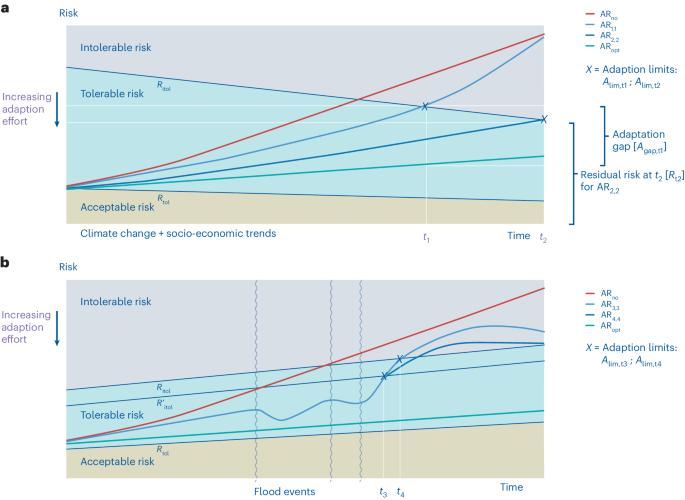Exploring the limits and gaps of flood adaptation
引用次数: 0
Abstract
Flood adaptation measures such as levees, flood-proofing structures, nature-based solutions and flood insurance are essential to cope with the growing flood risk caused by climate change and urban development into flood-prone areas. However, many communities in flood zones are ill-protected because the implementation of adaptation measures is hindered by a variety of constraints to adaptation, including the cost, limitations on institutional capacity and societal inertia. When adaptation efforts fall short relative to a desired level due to a combination of constraints, it results in an ‘adaptation gap’. Here we present a risk-based framework to systematically examine the technical, social and behavioural constraints that contribute to adaptation gaps. We argue that, without overcoming these constraints, adaptation gaps will widen under climate change, exposing increasing populations to heightened flood risk. This may then require more radical actions including relocation, as risks become intolerable. We argue that quantitative flood risk assessments must consider constraints and adaptation gaps systematically, especially where they may lead to flood adaptation limits. Without assessing these dynamic relationships, flood managers may overestimate the efficacy of flood adaptation measures and underestimate the unequal distribution of flood risks. This study addresses the limitations and constraints of flood adaptation. These limits could result in a growing ‘adaptation gap’ (the difference between actual and desirable flood risk), leading to unbearable risks and pushing communities in flood zones into retreat.


探索洪水适应的局限和差距
堤坝、防洪结构、基于自然的解决方案和洪水保险等洪水适应措施对于应对气候变化和城市向洪水易发地区发展所造成的日益增长的洪水风险至关重要。然而,由于适应措施的实施受到各种因素的制约,包括成本、机构能力的限制和社会惰性等,许多洪涝区的社区没有得到很好的保护。当各种制约因素导致适应努力达不到预期水平时,就会产生 "适应差距"。在此,我们提出了一个基于风险的框架,以系统地研究造成适应差距的技术、社会和行为制约因素。我们认为,如果不克服这些制约因素,气候变化下的适应差距将会扩大,使越来越多的人口面临更高的洪水风险。随着风险变得难以承受,可能需要采取包括搬迁在内的更激进的行动。我们认为,定量洪水风险评估必须系统地考虑制约因素和适应差距,尤其是在它们可能导致洪水适应极限的情况下。如果不对这些动态关系进行评估,洪水管理者可能会高估洪水适应措施的效果,低估洪水风险的不平等分布。本研究探讨了洪水适应的局限性和制约因素。这些限制可能导致 "适应差距"(实际洪水风险与理想洪水风险之间的差距)不断扩大,从而导致无法承受的风险,并迫使洪水区的社区退缩。
本文章由计算机程序翻译,如有差异,请以英文原文为准。
求助全文
约1分钟内获得全文
求助全文

 求助内容:
求助内容: 应助结果提醒方式:
应助结果提醒方式:


